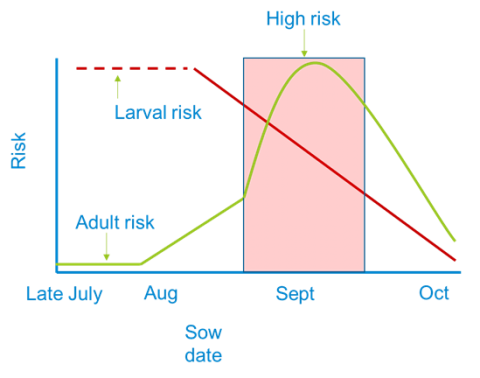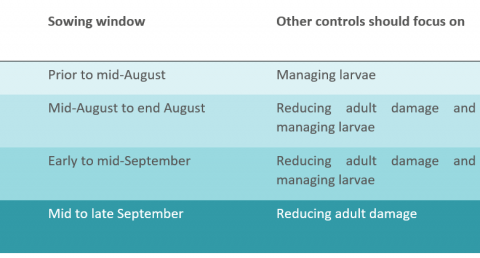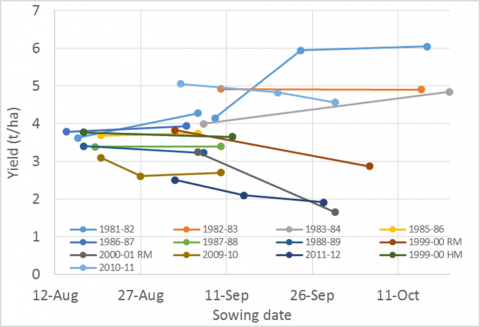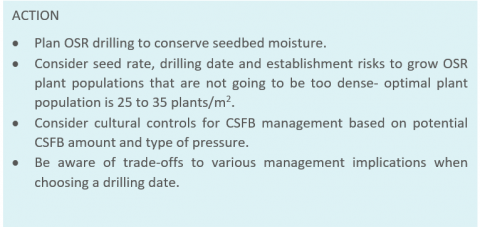Thomas Wilkinson, Sarah Kendall, Duncan Coston & Sacha White
OSR Establishment
As harvest approaches many will be thinking ahead to the establishment of their next OSR crop. Managing cabbage stem flea beetle (CSFB, Psylliodes chrysocephala) has become a major influence on OSR establishment choices for growers with some opting for, once considered unconventionally, early or late sowing dates to help mitigate the risk from adult CSFB feeding during peak migration.
Evidence from the AHDB project PR623 (available here) combined with recent trial data supports that the pressure expected from CSFB upon a crop can be dependent upon the sowing date. Crops at a later stage of development at CSFB migration suffered on average lower levels of feeding from adult CSFB (% leaf area lost), but earlier sowing dates were associated with higher autumn and spring larval loads per plant. This leads to a potential trade-off between early and late sowing strategies as to which type of flea beetle pressure (adult or larval) is likely to occur as illustrated below (figure 1.).

Figure 1. Visualisation of adult and larval damage risk trade-off for crops sown at different dates.
However, further cultural controls may aid in reducing the risk of some of these trade-offs by helping to manage either adult damage, larval pressure or both. Potential cultural controls could include, but are not limited to:
- Companion planting
- Trap cropping
- Use of stubble
- Organic amendments
- Straw management
- Establishment method
- Varietal selection
- Winter defoliation
- Adjusted seed rates
- Natural enemies
A summary of the cultural controls above can be found at the AHDB IPM hub here. As some of these may be more or less suited to mitigating adult or larval damage it could be beneficial to choose certain controls depending on the sowing date, and the aim to control either mainly adult damage, mainly larval damage or a mixture of both (Table 1).

Table 1. Examples of how sowing windows might relate to the focus of cultural controls
This could help refine appropriate IPM strategies. More information on the potential impact of sowing date on CSFB management strategies can be found at the AHDB blog here.
Testing these hypotheses in on farm situations is an aim of the current AHDB project “Reducing the impact of CSFB”. Although we are still to analyse the yield data and have not been able to test the impact of all the cultural controls listed in every drilling date situation, field scale trials investigating companion planting and organic manure inputs have shown that both of these controls can lead to the reduction of adult CSFB feeding in field situations.
Adjusting sowing dates can have impacts on other aspects of crop management. Varieties suited to sowing dates should be considered. The latest possible sowing date is later than may be initially perceived, as the chart of ADAS trials at different sowing dates suggests (Figure 10). Crops drilled later than the optimum window may suffer significant yield reductions due to poor plant establishment. In general, it takes 160°C days (the sum of average daily temperatures) to achieve 50% establishment from the time of sowing. Depending on water availability, a crop sown in mid-August will take about 10 days to emerge, while crops sown in the second half of September will take about 14 days.
Early drilled crops are more likely to build an overly large canopy and early sowing may have other impacts on logistics and the management of other pests and diseases (e.g. light leaf spot, clubroot, verticillium and aphids). More information can be found in the Bayer early sowing guide available here.

Figure 2. Effect of sowing date on yield, from a range of sowing date experiments carried out in the UK since the 1980s that have been reported in scientific literature.
It should be noted that within the background of CSFB management, other principles of good oilseed establishment almost always remain important, and some key aspects are discussed below. Conservation of any moisture in seedbeds is always key for getting the crop off to a good start and growers should remain vigilant that it only takes a few days of hot dry conditions to dry the top few cm of soil. Drilling into seedbeds low in moisture will not benefit the crop as germination and initial growth may be weaker (this may also exacerbate crop injury caused by adult CSFB feeding). Therefore, it is usually best to wait for the right soil conditions and/or when rain is forecast, also recognise that the optimum drilling window is longer than often perceived.
Though it is wise to have higher plant populations where the risk of pigeon damage or weed competition is high, a series of ADAS trials has shown that, in good conditions, the optimum OSR plant population is 25 to 35 plants/m2 for both conventional and hybrid varieties. Dense plant populations are more likely to develop overly large canopies and have an increased risk of lodging and may have a dense layer of petals that reflect light and prevent efficient photosynthesis in lower canopy layers. Crops with lower plant populations compensate by producing more branches and have increased numbers of seeds per pod compared with higher plant populations. The seed rate needed to achieve a target final population of 25 to 35 plants/m2 will depend on the percentage plant establishment and the number of volunteer oilseed rape plants. In typical cereal/OSR rotations the range of volunteer OSR plants is from 2 to 23 plants/m2. Establishment usually ranges from 50 to 80% but factoring in an average number of volunteers of 5 to 20 plants/m2, a target population of 25 to 35 seeds/m2 can usually be achieved from a seed rate of 30 to 40 seeds/m2. It’s recognised that targeting a seed rate to achieve a modest plant population is a challenge given the risk of CSFB and other establishment factors. Therefore, the final decision on seed rate should be made on the day of drilling based on seed-bed conditions.
Oilseed rape has a greater nutritional demand in autumn than cereals, so where soil indices of P, K or Mg are low (below 2) apply fertiliser to the seedbed. In some instances, a seedbed or early emergence top dressing of up to 30 kg N/ha will be beneficial, especially if straw has been incorporated, but generally only in crops drilled in early September and before.

